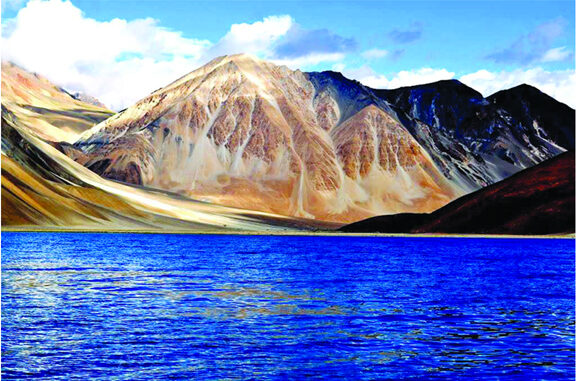
Ladakh is a union territory in the Kashmir region of India. Formerly falling in the state of Jammu & Kashmir, Ladakh was administered a union territory on 31st October 2019. Extending from the Siachen Glacier to the main Great Himalayas, Ladakh is a land like no other. Dominated by dramatic landscapes, Ladakh is known as the world’s coldest desert. Stunning Gompas (Tibetan Buddhist monasteries), fluttering prayer flags, whitewashed stupas, Ladakh is a riot of intricate murals and red-robed monks. It is said that only in Ladakh can a man sitting in the sun with his feet in the shade suffer from sunstroke and frostbite at the same time. With a culture similar to Tibetan culture, the people of Ladakh are friendly and welcoming to tourists. Ladakh is an adventure playground for rafting and high-altitude trekking. Note that Leh Ladakh is inaccessible by road outside the summer months. The route passes close altogether from around October to May, and the only way to reach is by air. Chadar trek on frozen Zanskar river takes place in January to the end of February.
For those of us living in the constant confusion about the difference between these twin locations, Leh-Ladakh, here is something that might help you. Ladakh is divided into two districts: district Leh and district Kargil. The former district has a famous town, “Leh”, and is a great tourist attraction because of its beautiful monasteries nearby, Shanti Stupa, cafes and Leh Bazaar defining the place’s culture.
While most of the people believe that Ladakh is inaccessible in the winters, this may be the best time to visit Ladakh for the adventurous souls. Winters in Ladakh hardly see any tourists and you can have all of its stunning barrenness to yourself. Visiting Ladakh in winters is a chance to see this magic land as it has existed for centuries.
Winter in Ladakh is very harsh and temperatures can plummet to lesser than -30 degree Celsius at night. So, be prepared for cold (brrr very cold) days and even colder nights. Everything will be frozen and there will be no running water in the taps. The streets look deserted and yet life goes on as usual. If you are lucky (or unlucky, depending on the severity of the snow), there is a huge possibility of experiencing snowfall while in Ladakh in the winters. While the aim of this winter travel guide to Ladakh is to help prospective travellers prepare, it is best to prepare yourself for thinking practically and trusting the locals when it comes to dicey situations. Follow this winter guide to Ladakh and it is quite possible to have a holiday to remember and boast about!
A warning—if you are someone who is not fond of the cold or cannot bear cold climates, please give up the idea of visiting Ladakh in winter. The biggest battle will be with the cold, and it is more a mind game than anything else. It is better to be prepared for extreme cold conditions before landing at 3300m above sea level.
How to reach?
Travelling by both the road routes, the Manali-Leh Highway and Srinagar-Leh Highway, is not possible since they are not open in the snowy winters of Ladakh. Flying is the only way to reach Ladakh once roads are closed for the winter due to snow at the high passes. The Manali-Leh and Srinagar-Leh highways are generally closed by October-November and November-December respectively.
There are several airlines that operate regular flights to Leh in the winter. You can get on to one of the early morning flights from Delhi or Jammu and Srinagar; the frequency of flights from Delhi is impressively high. The airfare is quite cheap (if you book in advance) as there only a handful of people come to Ladakh in the winters.
Tip: It is better to wear 4-5 layers of clothing at the departing airport itself to prepare yourself for the imminent cold of the Leh airport.
While you are in the flight, there are dazzling endless views of the snowy Himalayas on a clear day. There are chances of flights being cancelled or postponed due to fog and sudden changes in weather, so do remember to keep buffer of a day or two while flying into/out of Leh in winter.
Transportation in Ladakh
There are a few buses that ply in the winters in Ladakh and proper information about them can be obtained at the bus station in Leh. Depending on the snowfall at various places, the frequency and routes of the buses is decided. Buses are a great way to travel for budget travellers, also giving a chance to mingle with the locals. Commuting by motorcycle is not advised due to the harsh cold and increased chances of slipping on snow.
If you are looking for a comfortable way to travel, hired taxis (SUVs) are the best bet for travelling in the winter in Ladakh. Although taxi fares in Ladakh are quite steep, it is the most convenient option and also gives the flexibility to stop as often as you want for photography and sightseeing. Add to it the fact that the drivers, usually, will know someone at the destination to provide for a home stay in the bitter cold. Shared taxis run for some places near the Polo Ground early in the morning, and it is best to make a reservation. The taxi drivers will be reluctant to take direct bookings and will, instead, direct you to a travel agent. The main reason for it lies in the fact that if they get stuck somewhere the travel agents are liable to send another car to take you out safely. Dreamland Tours & Travels is a trusted choice and is a well-known name; remember to bargain when you are making a deal.
A recommended tip for winter travel within Ladakh, is to make sure that you arrive before dark to arrange for accommodation and food without any hassle.
Places that can and cannot be visited
Most of the internal roads in Ladakh are open even in the winter and traffic is sparse. So it is possible to visit most of the places in Ladakh even in the winter. Roads to Nubra Valley, Pangong Tso, Tso Moriri, remnants of the Indus Valley Civilisation, Sham Valley, Lamayuru, Kargil etc are all open and accessible throughout the winter.
It is important to know that in case of heavy snowfall, there are chances of the road being closed for a day or two and might hamper your plans. It is better to keep a day or two extra as heavy snowfall at Khardung La and Chang La may cause the roads to be shut for vehicular traffic.
The weather is bitterly cold in Changthang (near Tso Moriri) and the regions of Chushul and Hanle may be out of bounds in the winters. Stay prepared, for the unbearable cold (sometimes -40 degrees Celsius) makes Changthang a difficult place to visit in the winters even if you reach it.
It is also advisable to make have the vehicle window panes always rolled up so that there is minimal contact with the frigid air. Also remember that it is unbearably cold at Khardung La and Chang La (two of the highest passes in the world) and it makes sense to stay back in the vehicle while the driver makes the entries with the Army at the check post.





Be the first to comment